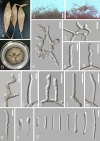One new species and one new record of Zasmidium in China
- PMID: 33510577
- PMCID: PMC7809012
- DOI: 10.3897/BDJ.9.e59001
One new species and one new record of Zasmidium in China
Abstract
Background: Two hyphomycetous species were collected from leaves of Smilax china (Liliales, Smilacaceae) and Cremastra appendiculata (Asparagales, Orchidaceae). ITS barcoding indicated that they belong to the genus Zasmidium.
New information: Morphological data in combination with molecular phylogenetic analyses based on ITS, LSU and rpb2 confirmed that our Chinese strains represented a new species, Zasmidium liboense and a new record of Z. citri-griseum.
Keywords: Dothideomycetes; Mycosphaerellaceae; asexual morph; one new species; taxonomy.
Yuan-Yan An, Xiang-Yu Zeng, Kun Geng, Kevin David Hyde, Yong Wang.
Figures



References
-
- Braun Uwe, Crous Pedro W, Schubert Konstanze, Shin Hyeon Dong. Some reallocations of Stenella species to Zasmidium. Schlechtendalia . 2010;20:99–104.
-
- Cheek, Martin, Lughadha Eimear Nic, Niskanen Paul M Kirk,Heather Lindon,Tuula, et al. New scientific discoveries: Plants and fungi. Plants People Planet. 2020;5 doi: 10.1002/ppp3.10148. - DOI
LinkOut - more resources
Full Text Sources
Other Literature Sources
